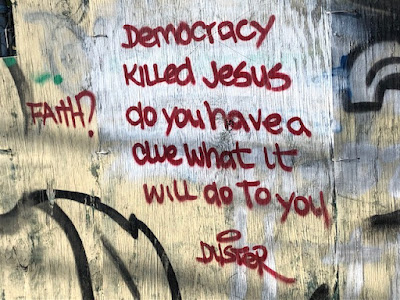The other morning, I set out for Connecticut. Dee-Lilah was certainly up for it: the sky was clear and bright, and a light wind rippled yellow leaves that line my street.
Across the RFK (Triborough) Bridge and the Randalls Island connector. Up the deserted industrial streets of Port Morris and Southern Boulevard to "the Hub," where the Boulevard meets White Plains Road and several subway lines. Traffic was almost as light as the wind (though not me, at my age!) all the way up to the Pelham Bay Bridge, where my visions of the perfect Fall ride to the Nutmeg State met with this:
"Oh, it must be Ian's fault," I thought. Though the Hurricane brushed by us two weeks earlier, the damage, if there had been any, was still there, I mused. But, peering ahead, I couldn't see it:
Then I glanced to my right and got the really bad news:
Spring 2023. If I could believe that, I wouldn't be so upset: I wouldn't be able to ride the Pelham Bay Trail to Westchester County during the rest of this Fall and Spring, but most of that wait would span the winter. But, if you know anything about New York City Department of Transportation projects, you know that Spring 2023 is most likely when the work will start. Then it will be further delayed by some dispute or another, and costs. Call me a cynic, but I've seen such scenarios play out too many times.
Oh, and when I looked on the city's website, I learned that the plan is to replace the bridge altogether. To be fair, it may well need replacement: The bridge wasn't designed for all of the traffic it handles (and, I might add, the bike/pedestrian lane isn't the greatest, but it at least takes you to the trail) and probably is falling apart.
I could have taken one of the routes I rode before I discovered the bridge and trail. But, instead, I wandered in and out of the Bronx and Westchester County. Guess where I took this photo:
It's a view from the Bronx, but not from where even people who know the Bronx might guess. At the far eastern end of the borough, there is a neighborhood with the seemingly-incongruous name of Country Club. The neighborhood was indeed the location of the Westchester Country Club before the Bronx became part of New York City. But, in a way, the area still has a "country club" feel: It's effectively an island, cut off from the rest of the Bronx (and New York City) by water, I-95 and Pelham Bay Park. The houses come in all ranges of styles, but they have this in common: they're big, more like the ones you find in the far reaches of Long Island or New Jersey. The few buildings that aren't single-family houses or small stores or restaurants (mostly Italian and, I suspect, good) are condos, some with their own marinas!
Just on the other side of the highway is another neighborhood that seems to have been untouched by the "burning Bronx" of the 1970s. Like Country Club, it has many Italian-American families and remarkably clean public spaces. And it has a store that seems to have been kept in a 1950s time capsule:
Frank Bee. Transpose the "ee" on Frank, and you could have a nickname for someone in the neighborhood--or a DJ. Frankie B. Now that sounds like a name people would associate with the Bronx.
Just by those signs, you can tell that, like Country Club, Schuylerville has a lot of Italian-American families whose kids Trick-or-Treat freely in the neighborhood. While very little in the store falls into the price range advertised on the store's banner, the prices are actually very good, especially compared to those in other parts of the city.
Whatever happens, I hope the store--and those signs and mannequins--stay where they are. In an ideal world, such friendliness would be an antidote against the odious bellowings of would-be oracles:
Now, I'm not a political scientist and I'm an historian only if you define that term loosely. That said, in my understanding, the notion that "Democracy killed Jesus" is wrong on two counts.
First of all, Pontius Pilate wasn't an elected official; he was an occupying Roman. Second, and more important, an angry mob agreeing on something and acting on it isn't democracy, especially if it doesn't reflect the wishes of most people--or, as in the case of Jesus (if he indeed lived and died as he did in the stories passed on to us), if most people didn't even know about the accused or his alleged deeds.
Did that bit of graffiti reflect what most people in Country Club or the Bronx believe about the death of Christ or democracy? I suspect not. Whatever they think, I have to say this for them: They, whether they were walking, raking their leaves or even driving, were very nice and a couple even cheered me on. What I didn't tell them, of course, is that Dee-Lilah, my custom Mercian Vincitore Special, makes me look like a better rider than I am!😉










